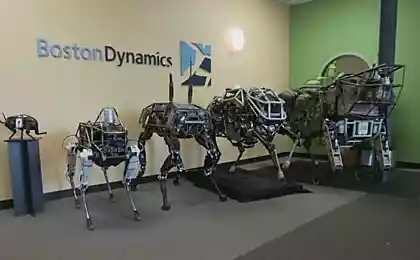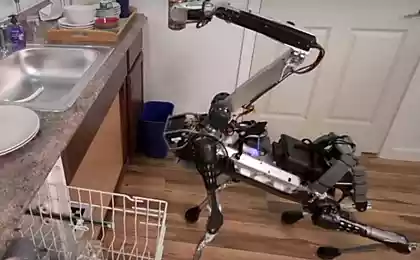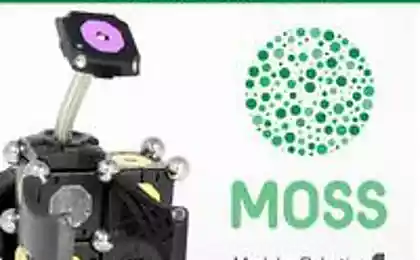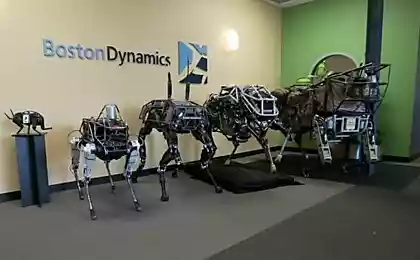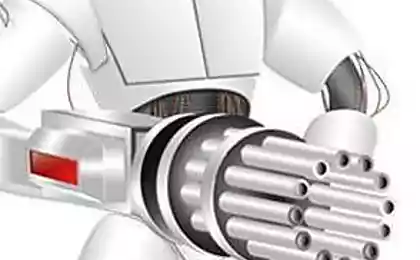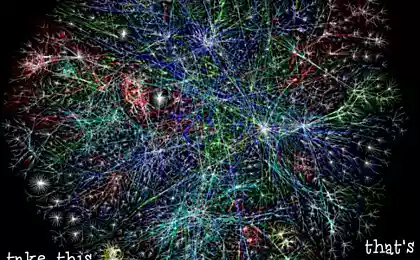3182
Who came up with nanotechnology?
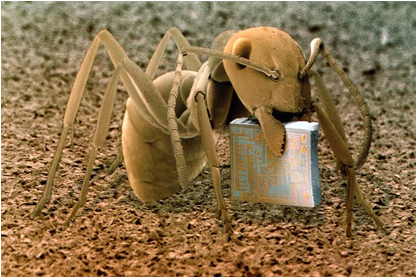
Less than a month to begin BAL ROBOTS , but still so much to write about! Here, for example, nanotechnology - many associate with them the future of robotics, but very few do imagine the story "nano».
In the yard in 2014, we are very close to миниатюрным machines , consisting of individual atoms. There are already nano-tubes and a noise creating graphene. US Congress promises 2030 offensive singularity and release anthropomorphic robots based on nanomaterials.
It is not even a definition of the term "nanotechnology", and the history of the term is complex and messy - that will deal with it.
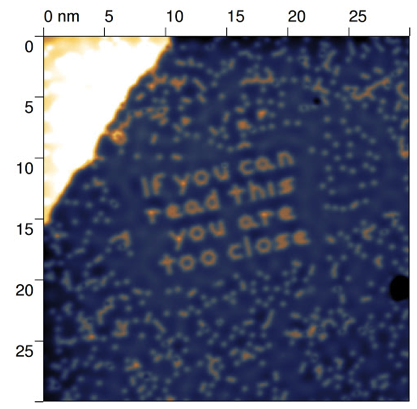
It is believed that nano-technology has its origins in the report Richard Feynman « At the bottom of a lot of space, "Then Feynman surprised listeners general arguments about what would happen if only the beginning of the miniaturization of electronics will reach its logical extreme, the" bottom ".
But this is only because it is considered the reality of nanotechnology originate only in 1989, but then fell in the scientific revolution and the report Feynman, but first things first.
During the second half of the 20th century evolved as miniaturization technologies (microelectronics) and monitoring tools atoms. Milestones such microelectronics:
- 1947 - The invention of the transistor;
- 1958 - the emergence of the chip;
- 1960 - photolithography technology, manufacturing microchips;
- 1971 - the first microprocessor company "Intel" (2250 transistors on a single substrate);
- 1960-2008 - action "Moore's Law" - the number of components per unit area of the substrate doubled every 2 years.
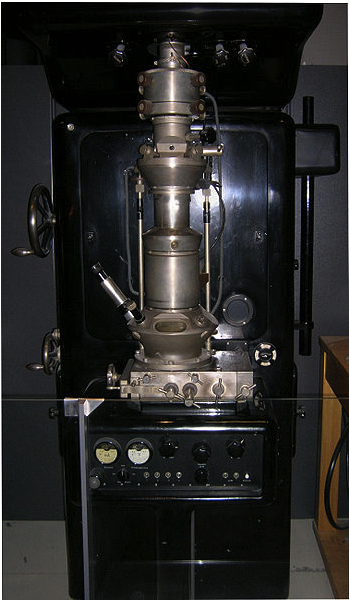
- 1932 - E.Ruska invented a transmission electron microscope. According to the principle of action it is similar to a conventional optical, only instead of photons - electrons, but instead of lenses - a magnetic coil. The microscope gave an increase of 14 times.
- 1936 - E.Myuller proposed construction field emission microscope with an increase of over a million times. According to the principle of action, he is like a shadow theater: the screen displays images of microscopic objects located on the tip of the needle, the radiating electrons. However, defects in the needle and chemical reactions did not allow to obtain an image.
- 1939 - Transmission electron microscopy was Ruski increase of 30 thousand times.
- 1951 - Müller invented the field ion microscopy and get images of atoms on the tip of the needle.
- 1955 - The world's first images of individual atoms, obtained ion microscopy.
- 1957 - The world's first images of individual molecules obtained field electron microscope.
- 1970 - The image of a single atom, the resulting transmission electron microscope.
- 1979 - Binnig and Rohrer (Zurich, IBM) invented the scanning tunneling microscope with a resolution of no worse than the above.
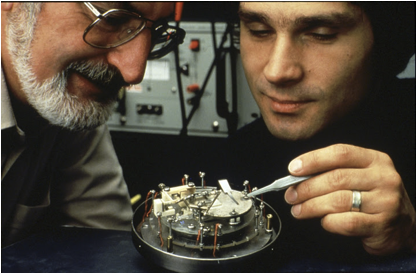
But that's not it. In the world of elementary particles, quantum mechanics is valid, and therefore can not be separated from the observation of the interaction. Simply speaking very quickly turned out that the microscope can cling and move molecules, or to change their electrical resistance simply by press.
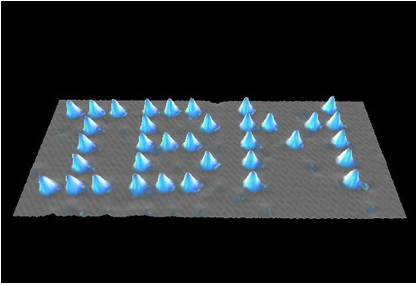
In late 1989, the scientific world had spread sensation: man learned to manipulate individual atoms. Donald Eigler of IBM employees who worked in California, wrote on the metal surface of your company name 35 xenon atoms. This picture is subsequently replicated global media and already settled on the pages of textbooks, marked the birth of nanotechnology.
On repeating the success immediately (in 1991) reported by Japanese scientists have created the inscription «PEACE" 91 HCRL "(Peace in 1991. The Central Research Laboratory HITACHI). True, they did this inscription whole year and not at all by placing atoms on the surface, and vice versa - picked out unwanted gold atoms from the substrate.
Eigler actually repeat the achievement was only in 1996 - in the Zurich laboratory IBM. As of 1995 the world was only five laboratories involved in the manipulation of atoms. Tree in the United States, one in Japan and one in Europe. At the same time European and Japanese laboratories owned IBM, that is, in fact, too were American.
What could the European politicians and bureaucrats do in this situation? Just shout about the evils of progress for the environment and dangers of new technologies in American hands.
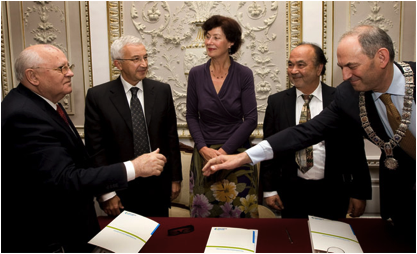
Back in the 1970s, the famous «римский Club »advanced ideology of" sustainable development. " In the report "The Limits to Growth" explicitly states that the old Europe is unbearable chasing America, and therefore need to promote the idea of "conservation achieved" - well, there to protect the environment and impose quotas on industrial development under the guise of protecting the atmosphere.
Eric Drexler - definitely" son of the regiment "Club of Rome and the leading advocate of European values in the states. Popularizer of science, politics and "how to engineer", a youth pierced with ideas of "limits to growth».
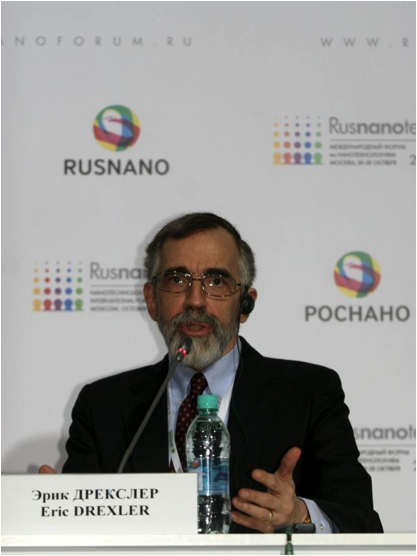
In 1986 he published his book "Engines of Creation" and created the "Institute of foresight." The book describes the nanorobots capable of creating their own kind, as well as the situation, when they go out of control, "gray goo" nanobots ecophages-planet leads to an ecological catastrophe. Meme "nano-goo" was quite popular in the media of the early nineties. Drexler himself is often called the father of almost nanotechnology.
What is not true is wrong, because it is the achievement of nanotechnology laboratories IBM. But it so happened that in popular culture is the theme launched Drexler and loud splash in the nanoworld occurred exactly at the time of the great popularity of his book "Engines of Creation".
So the role of Drexler was key in this story. In summer 1992, Senator Albert Gore invited him to speak to the Senate on "New technologies for sustainable development." A year before the speech, he defended his MIT thesis "Molecular machines: production and use of computers" and being a great orator, was able to convince the senators to reality and the practical benefits of manipulating molecules. Thus was born lobistskaya group in the US Senate and "nanotechnology" moved into the realm of politics. The next year, Gore became Vice President of the United States.

It is worth remembering that we are talking about the beginning of the nineties - the "cold war" ended and the US government squandered scratching your head in search of direction freed from war billion. Ecology, environmental protection, nanotechnology and "sustainable development" sounded great and could easily win the tender. There was only one problem.
American industrialists and scientists did not want anything "stagnant", they wanted to capture world markets, build new accelerators and earnings growth with the Nobel Prize. Al Gore, as Vice-President (1993-2001) never uttered about "sustainable development", even in his report, "the development of science in the national interest" (1994) Nanotechnology mentioned only in passing. Although after the resignation, already as a private person and Gore returned to the ideas of nanotech and the Club of Rome, for which he received the Nobel Peace Prize for fighting global warming (2007).
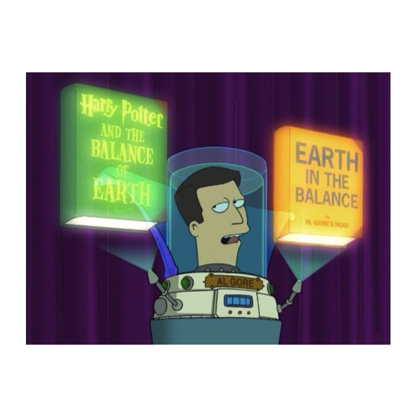
All of this has shaken the scientific position of the writer Drexler. To him and to make claims of "weak science" and "Institute of foresight" no, no, yes charlatan sect called - and here also the vice-president supported the idea only partially. According to the report of Horus, nanotechnology to be used not for environmental purposes, and for the development of American industry!
This is where the magic begins.
On the one hand, the National Science Foundation, scientists and industrialists believed Drexler and his nanotechnology quackery, but on the other - the flywheel discuss initiatives have already been launched at the top and under the study was planned to allocate substantial sums.
Thus it was in the second half of the nineties and have all seen how effectively Gore was able to develop other innovative project - the Internet.

in 1996, Clinton and Gore pave lokalku School i>
Few people know, but it was the efforts of Horus was fully financed the creation of the infrastructure of the Internet, and even the first browser - mosaic . But most importantly, Gore administration has created the conditions for investment in the Internet. What brought explosive growth of the industry in 1999 and the super-profits for participants titled "dotcom boom". It all ended крахом "Dotcom bubble» just a year later, but the deed was done. Despite the market collapse, Gore deserved called the "father of the Internet", without it all would appear ten years later - and even Google and Habr.
Inevitably the question arose - and not whether nanotechnology promise the same fast profit as the Internet? Worth a try.
In 1999 the project "National Nanotechnology Initiative" finally lay down on the table of the President. The project was so well designed and groomed, that there were some problems. If the environment is thrown, sustainable development and forgot mechanosynthesis dissolved in hundreds of other technologies specifically why spend all that billions of dollars? What specifically will America NNI? No explanation was not followed.

NNI was launched in 2000 with a speech to students at Caltech Clinton. Her government funding totaled $ 300 million, and increases all subsequent years, regardless of the political conjuncture (1.8 billion. In 2011, approximately 10% of the budget of NASA).
Clinton addressed the audience where Feynman back in 1959 made his famous report. It was introduced into scientific circulation Drexler in 1989, to use it to its fullest. Therefore nanotech legend unfairly ascribes the first impetus to Feynman.
But themselves "nanotechnology" were only cause more problems. From the start of the initiative passed 14 years, tens of billions allocated and where the result? We can assume that he is classified. Or ... just not engaged with what we expect.
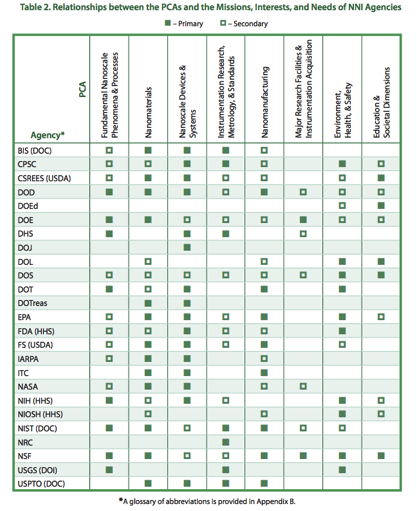
If we admit the existence of the NNI hidden kernel type program to create anthropomorphic robots, so that the union of dissimilar directions within a single program seems quite logical. As for the union of the 25 departments and agencies, including key NSF, DOE, DOD, NIH, NASA and NIST. And lack of funding problems for 14 years.
You can still recall that Boston Dynamics, impressed the audience examples of robots that came out of MIT right in 1992 - immediately after Drexler defended a dissertation, which consisted of common words, promises and forecasts ... On the other hand, the reviews speak openly about the possible the use of nanotechnology in the production of a wide variety of robots for the needs of the Ministry of Defence - from nanomachines to mechanical man is not distinguishable from the present.
Overall NNI made a strong impression on Europe. But that would somehow control, develop or prohibit "nanotechnology" - you need to define them.
In contrast to the NNI, in the European program "Nanotechnologies, Materials and Processes", was clearly told about "sustainable development" and about the possibility of future conversion of "nanotechnology" in "Environmental Technology". In 2004, total financing "nano" in the EU amounted to 1 billion. Euro (in England - 45 mln.f.st.).
And only in 2011 the Commission finally adopted the formal concept of "nanomaterials": they share a particle size of 1-100 nanometers (at least in one dimension!) Is from 1 to 50 percent. Emphasizes that fullerenes, graphene flakes and carbon nanotubes also belong to nanomaterials.
Under this definition misses anything. It makes even nanotechnology housewife kapnuvshuyu oil on the water surface. That is, under the brand name of nanotechnology may be hiding anything.

Source: habrahabr.ru/company/balrobotov/blog/221193/











